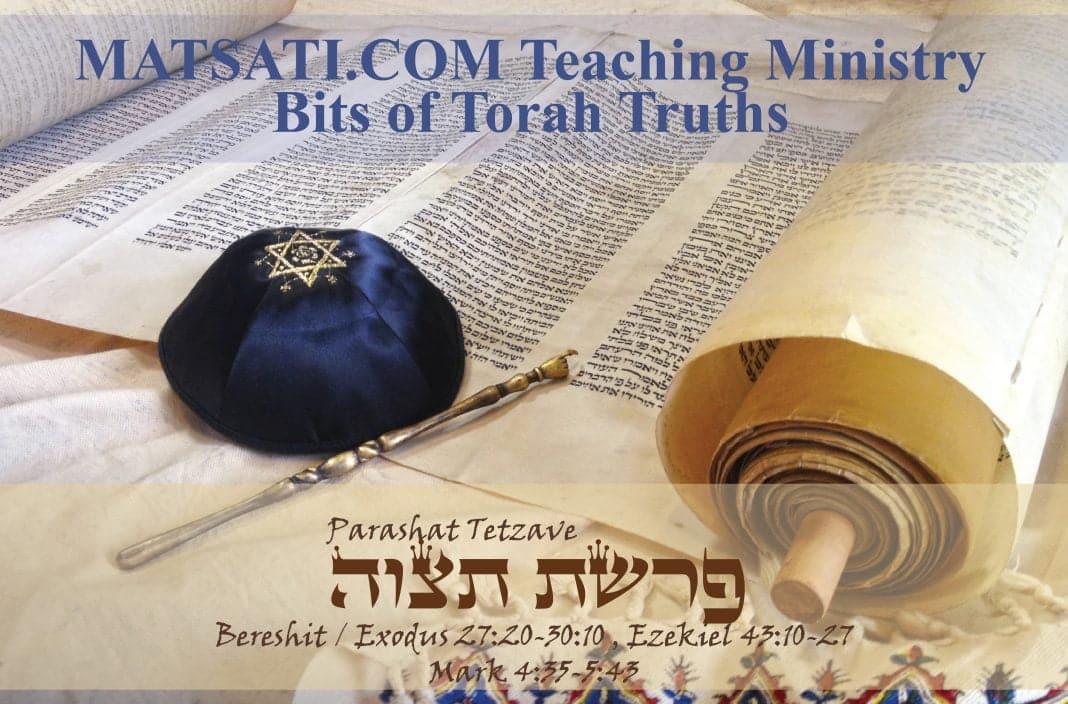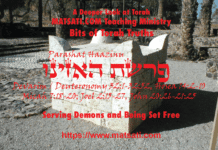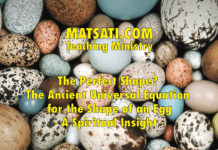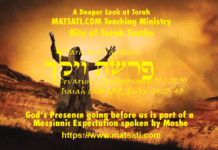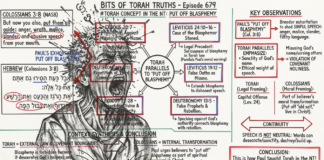[youtube url=”https://www.youtube.com/watch?v=AeZJ3Ab7ksg&feature=youtu.be”]
This weeks reading is from Parashat Tetzave (Shemot / Exodus 27:20-30:10), which details the construction of the priestly garments. Aaron’s garments are said to consecrate him for the purpose of ministering before the Lord (28:3). The Priestly garments consist of various parts, the breast-piece, the ephod, a robe, a turban, and a sash (28:4). The ephod was inlaid with two onyx stones contain the engraving of the names of the tribes of Israel (28:9) and twelve precious stones are set in the breast-piece one for each tribe (28:17-22). We are told the Urim and Thummim are placed in the breast-piece so that they are over the High Priest’s heart continually. The biblical record of the Urim and Thummim are significant when it is understood that Urim (light) and Thummim (innocence) are simply the plural forms of the Hebrew words for light and innocence. Based upon a Hebraic way of thinking, light is synonymous to God’s truth, and innocence is synonymous to walking peacefully with our God and with men (e.g. walking in Justice, Truth, and Righteousness). The Scriptures tell us that the Lord instructs Moshe to consecrate Aaron and his sons as priests with a bull and two rams without blemish (29:1). The consecration of the priests for service to the Lord is emphasized in the idea of being a light unto the nations, and living in innocence and truth before God. The putting on of the special garments for service before the Lord (29:5-6) and anointing with oil (29:7) may be paralleled to ordering our lives and being filled with the Spirit of God. The Lord says He will consecrate the tent of meeting, the altar, and the sons of Aaron as priests. Note also that Aaron and the priests are also to consecrate the holy place of God because the Lord is to be respected for the work that He has performed in consecrating them. The Parashah concludes with the Lord saying “I will dwell among the sons of Israel and will be their God.” These aspects of consecrating and setting apart are a part of the Lord God dwelling in our midst.
The concept of light, truth, innocence, righteousness, justice, and holiness are all Torah principles. In the rabbinic literature, often the rabbis make statements that both instruction and the Torah are the light of God. Why do the rabbis consider both teaching and the Torah the light of God?
ספר שמות פרק כז
כ וְאַתָּה תְּצַוֶּה | אֶת-בְּנֵי יִשְֹרָאֵל וְיִקְחוּ אֵלֶיךָ שֶׁמֶן זַיִת זָךְ כָּתִית לַמָּאוֹר לְהַעֲלֹת נֵר תָּמִיד: כא בְּאֹהֶל מוֹעֵד מִחוּץ לַפָּרֹכֶת אֲשֶׁר עַל-הָעֵדֻת יַעֲרֹךְ אֹתוֹ אַהֲרֹן וּבָנָיו מֵעֶרֶב עַד-בֹּקֶר לִפְנֵי יְהוָֹה חֻקַּת עוֹלָם לְדֹרֹתָם מֵאֵת בְּנֵי יִשְֹרָאֵל:Shemot / Exodus 27:20-21
27:20 ‘You shall charge the sons of Israel, that they bring you clear oil of beaten olives for the light, to make a lamp burn continually. 27:21 ‘In the tent of meeting, outside the veil which is before the testimony, Aaron and his sons shall keep it in order from evening to morning before the Lord; it shall be a perpetual statute throughout their generations for the sons of Israel. (NASB)
In the Scripture reading for this week, Shemot / Exodus 27:20-21 states that the menorah that stands in the inner sanctuary is to be kept burning continually. Israel is instructed to bring clear oil derived from beaten olives to be used to keep the menorah burning. This is to be a perpetual statute throughout their generations for the sons of Israel. Due to these opening verses in Parashat Tetzave, the rabbis devote the majority of Midrash Rabbah Shemot, Parashat 36 to the idea of the olive oil that is commanded to be brought for the menorah in the Tabernacle. Part 3 of Midrash Rabbah has some interesting points to make concerning the Torah, instruction, and light.
Midrash Rabbah Shemot, Parashat 36, Part 3
Another explanation of, A leafy olive tree. Just see how the words of the Torah give forth light to a man when he studies them; but he who does not occupy himself with the Torah and does not know it, stumbles. It can be compared to one who stands in a dark place; as soon as he starts walking, he stumbles against a stone; he then strikes a gutter, falls into it, and knocks his face on the ground, and all because he has no lamp in his hand. It is the same with the ordinary individual who has no Torah in him; he strikes against sin, stumbles, and dies, while the Holy Spirit exclaims, He will die for lack of instruction (Mishley / Proverbs 5:23); and instruction means the Torah, as it says, Take fast hold of instruction, let her not go (Mishley / Proverbs 4:13). He dies, because he knows not the Torah and goes and sins, as it says, The way of the wicked is darkness; they know not at what they stumble (Mishley / Proverbs 4:19). But those who study the Torah give forth light wherever they may be. It is like one standing in the dark with a lamp in his hand; when he sees a stone, he does not stumble, neither does he fall over a gutter because he has a lamp in his hand, as it says, Thy word is a lamp unto my feet, and a light unto my path (Tehillim / Psalms 119:105), and also, And if you run, you will not stumble (Mishley / Proverbs 4:12), and also, The spirit of man is the lamp of the Lord (Mishley / Proverbs 20:27). God said, Let My lamp be in your hand and your lamp in My hand. What is the lamp of God? The Torah, as it says, For the commandment is a lamp, and the teaching is light (Mishley / Proverbs 4:23). Why is the commandment a lamp? Because if one performs a commandment it is as if he had kindled a light before God as if he had revived his own soul, also called a light, for it says, The spirit of man is the lamp of the Lord (Mishley / Proverbs 20:27). Why is teaching called light? Because it often happens that when one is eager to fulfill a precept, his Evil Inclination within him dissuades him, saying, Why do you want to perform this command and diminish your wealth? Instead of giving away to others, give it to your own children. But the Good Inclination says to him, Give rather to a pious cause; for see what it says, For the commandment is a lamp; just as the light of the lamp is undiminished even if a million wax and tallow candles are kindled from it, so will he who gives towards the fulfillment of any commandment suffer a diminution of his possessions. Hence, For the commandment is a lamp, and the teaching is light.
According to Midrash Rabbah Shemot, Parashat 36, Part 3, the rabbis taught that the words of the Torah give forth light to a man when he studies them. They say that he who does not occupy himself with the Torah and does not know it, stumbles. Examples are given to clarify the meaning of stumbling without the light the Torah provides. The idea is that when one does not know the Torah, he will stumble due to sin and die. The point is that without the Torah one would not know he sins, and the example given is from King Solomon in Mishley / Proverbs 4:19 saying that “The way of the wicked is darkness; they know not at what they stumble.” The midrash states that the Torah functions as a lamp for us to see where we can walk without stumbling due to sin (Tehillim / Psalms 119:105). In addition, the proverbs tells us that “The spirit of man is the lamp of the Lord” (Mishley / Proverbs 20:27). The most fascinating aspect of the midrash is the statement that says:
God said, Let My lamp be in your hand and your lamp in My hand. What is the lamp of God? The Torah, as it says, For the commandment is a lamp, and the teaching is light (Mishley / Proverbs 4:23).
The idea is the one who performs a commandment (maasim tovim) it is as if he has kindled a light before God. The midrash states “The Torah, as it says, For the commandment is a lamp, and the teaching is light” (Mishley / Proverbs 4:23). Both the concepts of performing a command (mitzvah) and teaching (instruction) are paralleled to a lamp or light. The rabbis ask the question of why is teaching called a light? they say, “Because it often happens that when one is eager to fulfill a precept, his Evil Inclination within him dissuades him, saying, Why do you want to perform this command and diminish your wealth?” Why do you think the Yetzer Hara (Evil Inclination) is used as the Nimshal (נמשל) to explain the rabbinic analogy on “teaching” being called “light?” They say that the Yetzer Hara will argue against the Torah command to give to others (take care of the poor). The example given is to give to your own children so that one’s wealth does not leave the family.
The concept of “God’s light” means that the Lord is the source and measure for all that is true. Another way of putting this statement is that nothing is truly understood until it is understood in the light of the Word of the Lord. This is why the Solomon states, “The fear of the Lord is the beginning of knowledge” (Mishley / Proverbs 1:7). The Lord is the source of all that is true, and the reason the Apostle John used the word “light” in his opening verses to the Gospel of John is because the light carries a positive connotation that God’s word is truth, and God’s truth is found in Yeshua the Messiah. The reason John chose the word “light” is because it promises the truth of God, and in a similar manner, the reason the Torah is called the “light” of God is because contained within the Torah is the truth of God which is full of joy and hope. One of the major aspects of the “light” of the Torah is the truth, hope, and joy that is found in the command, not only to walking with the Lord and in His ways, but in the expectation of God’s Messiah Yeshua. Take for example, studying the Aramaic translations, the Targum Pseudo-Jonathan and Neofiti provide us with an interesting insight into this verse from Shemot / Exodus 29:33 on eating the things by which atonement was made.
Targum Neofiti
לג ויאכלון יתהון די יכפר אתכפר בהון למשלמה ית קרבן ידיהון למקדשא יתהון וחילוניי לא יאכל ארי קדש אינון׃Targum Pseudo Jonathan
לג וייכלון יתהון דאתכפר בהון לקרבא ית קרבנהון למקדשא יתהון לשמשא קדמי וחילוני לא ייכול ארום קודשא הינון:
The literal translation of Targum Pseudo-Jonathan provides us with this insight on the importance of the Sacrificial system. The Targum states, “ויאכלון יתהון די יכפר” saying “and you are to eat the one who atones,” “בהון למשלמה” “with regard to being complete, to make true, scripture being fulfilled or made perfect,” “ית קרבן ידיהון למקדשא” “at the hand of the sacrifice which sanctifies you.” It is important to note when studying Hebrew and Aramaic, in the Semitic languages, word order may be used to place emphasis upon a particular aspect of what is being said or written. Here in Targum Pseudo Jonathan, the text states “ית קרבן ידיהון למקדשא” “at the hand of the sacrifice which sanctifies you” where the Aramaic word order is different from that of the English translation. The Aramaic word ית is used to introduce the direct object (Sacrifice). This is synonymous to the Hebrew word את used to introduce the same (a direct object) in Hebrew grammar. Also, this word is not translated into English as a definite direct object marker because the English language accomplishes this by word order in the same way that Hebrew and Aramaic do with the words את and ית respectively. (Take for example, the sentence “The dog bites the man.” If we change the word order in English to “The man bites the dog,” the meaning of the sentence changes. This is not so in Hebrew and Aramaic since את or ית is placed before the object. The sentence would be written in Aramaic as “The dog bites ית the man.” Therefore, one is able to give emphasis on the man by changing the word order saying “ית the man bites the dog” and the person reading or listening would still understand the dog as biting the man regardless of the word order.) The Aramaic translation, according to Targum Neofiti, specifically states that the priest is to eat “ית the sacrifice” so that “the scriptures may be fulfilled or made perfect.” Emphasis is placed upon the sacrifice, consumption, and the fulfilling of the Scriptures. By eating the sacrifice the priest incorporates (internalizes) the thing that bears the iniquity of the offerer. The purpose was so the priest could then go before God and make atonement before God. The concepts found here in the Torah on the consumption of the sacrifice is so the priest could function to bear the sin of the people (eating and making it a part of the body) and then going before God to make atonement on behalf of the people. The Torah principle, the teaching here, the light or truth of God is that the life of the animal is laid down as a substitute for our lives and there is a need for a Priest to bear our iniquity in order to make atonement before God. The truth of this Torah principle is that this is done in the place and the way that God requires. The sacrificial laws given in the Torah provide for us a future expectation of the Messiah. The Lord God in heaven, our Father, brought His Messiah, as Prophet, Priest, and King. Yeshua the Messiah provided atonement in offering his life as “the Lamb of God slay from the foundation (יסוד) of the world” (1 Peter 1:19-20, Revelation 13:8). The concept of instruction being light that is paralleled to the truth and the word of God, found within the Torah, is the expectation of the Messiah through whom we would receive the forgiveness of sins. Throughout all of Scripture, like the emphasis here in this weeks reading on the Sacrifice, emphasis is placed upon the sacrifice from the Lord, the True Lamb of God, Yeshua the Messiah! How can we not believe and receive the One in whom we have the forgiveness of sins? Believe and be saved! Yeshua is the Messiah of God! BTT_Parashat Tetzave-2015
